Canberra Doctor is proudly brought to you by the AMA ACT Limited
CIRCULATION: 1,900 IN ACT & REGION


Canberra Doctor is proudly brought to you by the AMA ACT Limited
CIRCULATION: 1,900 IN ACT & REGION


Informing the Canberra medical community since 1988

Leading doctors are breathing a sigh of relief to hear the ANU has committed additional funds to keep its medical program alive, emphasising the vital role the program plays in the region’s health and hospital system.
Under scrutiny from the Australian Medical Council, the ANU agreed in July to extend the current interim funding for the School of Medicine and Psychology by one year, to the end of 2026. The new funding includes “coinvesting with Canberra Health Services in senior academic clinical leadership positions”, an ANU spokesperson confirmed.
It follows a warning letter from the AMC in June seeking assurances from ANU in relation to the program’s ongoing accreditation. The university responded on 29 July by “confirming that all financial support is made available for the program to maintain its accreditation”,
the spokesperson said.
“In addition to extending the interim funding, the university assured the AMC it is working with CHS and the ACT Health Directorate to draft a business plan by the first quarter of 2026, to ensure the security of funding for the medical program beyond 2026,” the spokesperson said.
The welcome development comes amid a nightmarish period for the ANU, as it looks to shed $250 million in operating expenses.
The institution has suffered ongoing reputational damage in recent weeks, including bullying allegations against its Chancellor Julie Bishop (which she denies), and public outcry that the highly regarded School of Music is in jeopardy. ANU is currently under investigation by the university regulator, the Tertiary Education Quality and Standards Agency.
In the wake of the AMC’s letter and the university’s response, many doctors involved in medical education in Canberra
have contacted AMA ACT, expressing relief that the medical program looks set to survive ANU’s cost-cutting crusade.
Professor Paul Gatenby, Foundation Dean of the ANU Medical School said it was “a relief that the medical school is proceeding”. One of the main reasons the program was established in 2003 was to resolve a medical workforce crisis in Canberra and the surrounding NSW region. Although the proportion of ANU medical graduates choosing to remain in Canberra for their internships has declined in recent years, ANU remains the main supplier of graduate doctors for CHS, and in 2025 half of the CHS intern cohort came from ANU.
Professor Imogen Mitchell, a former Dean of the medical school and current Executive Director of Education, Research & Academic Partnerships at CHS, a joint appointment with the ANU, said she hoped the new funding was a sign the program was “getting back on track where we should be”.
“As a former Dean, I know

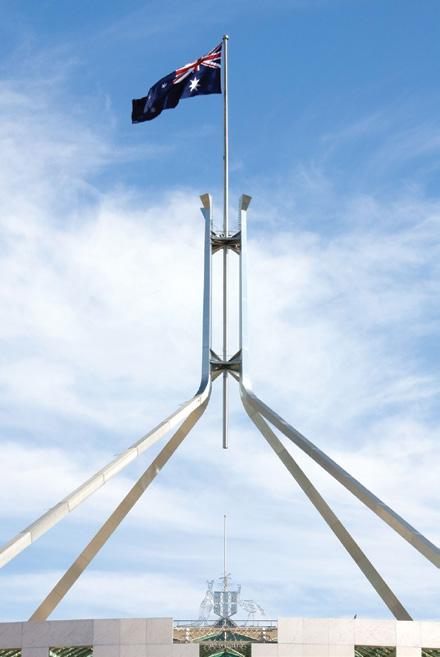
how hard it is to get funding commitments for the medical program,” Professor Mitchell said. “To me, this new commitment from ANU is groundbreaking.”
Professor Mitchell said she was especially encouraged by the renewed investment in clinical academic leadership positions. “I’m hopeful that we are seeing a new era of improved collaboration between the ANU and CHS, where there is agreement about the importance of investing in these leading
clinical academic roles,” she said. Clinical academic positions – e.g. Professor of Medicine, Professor of Surgery, Professor of Obstetrics and Gynaecology – have been a feature of ANU’s medical program throughout its 20-year history, initially funded by the ACT Government.
These roles are seen as advantageous to ensuring the medical program retains relevance to real-world medical practice, while also strengthening Canberra’s health


Walking around the lake on Sunday, seeing the blossoms on the trees, I reflected that winter is coming to an end. The winter season tests the mettle of our health system, and this year has seen record numbers of influenza, record-breaking attendances at our emergency departments, and resources within all parts of the health sector stretched to the limit.
I have heard from doctors, nurses and allied health professionals about the daily strain, and the quest to do the best for their patients, and would like to acknowledge all our members who step up, do more with less, and continue to provide high quality medical care to the people of Canberra and the surrounding regions.
In August I attended the AMA National Conference in Adelaide. The program was packed with inspirational speakers, but one of the highlights for me was the Advocacy Panel which included Dr Chris Moy, Dr Omar Khorshid, Dr Michael Bonning and Ms Lara Giddings, AMA Tasmania CEO. Lara dropped her AMA hat for a moment and spoke about what it was like to sit on the other side of the advocacy table when she was Tasmania’s Health Minister and then Premier, and the features of the most effective, and therefore implementable, advocacy positions.
We have many strategies for advocacy. There is the visible – the large media campaigns – and then
there are the things that we do that are quiet – identifying the problem, and working together to find solutions. I am often reminded that I cannot achieve everything that we want for our members, but I will be there, in the room negotiating, trying to find practical and implementable solutions that work for our patients and our doctors. Along those lines, it has been a busy few months meeting with leaders of our local political parties, and being interviewed in the media. I would like to thank our members who consistently respond to assistance for talking points when I reach out for advice across the huge breadth of topics that we speak to. Your willingness to share your knowledge benefits our community. Recent topics have included the growing problem of body dysmorphia in young men, workplace violence, the exponential rise in ED presentations, and the Paediatric Early Warning System. When we look to the next few months our focus will be on addressing resources for our public hospital system, the ongoing concerns about erosion of clinical autonomy, and how we ensure that Canberra remains a viable place for training our specialists of the future.
Workplace relations has always been the bread and butter of the AMA ACT and remains as important as ever, especially given the enormously stressful conditions many of our doctors are currently working under. Over the last few months, the AMA ACT team have been involved with significant workplace relations efforts in support of individuals and teams who are enduring very difficult professional situations.
The
The details are not things we can talk about publicly – this work is largely unseen, with many early morning and evening meetings behind closed doors. However, I mention it because these efforts, though rarely acknowledged, are fundamental to shaping safer medical workplaces and a stronger health system for all Canberrans. Every time I leave these meetings I am reminded of how important it is to have a strong AMA. I would like to thank all our members, without whom this vital work could not happen, and say to those involved in ongoing negotiations, we are right there with you and are working hard on your behalf.
It is because we need a strong AMA in the ACT that our office and board commenced discussions in May about AMA ACT’s future, with a proposal for our branch to become part of the Federal AMA. The proposal is aimed at ensuring the sustainability of AMA ACT into the future, while also preserving AMA ACT’s identity – including its name, branding and leadership. We recently conducted an electronic straw poll of members, in which the proposal received a high level of support. This poll also provided us with valuable feedback about matters for the Board to consider.
While many respondents saw the proposed move as forwardlooking, I am aware that to many, this is a sad but necessary development. I am grateful for the constructive discussions I have had with members on this topic lately, and the frank and fearless feedback provided. In the coming months we will continue to engage with our membership as we develop the transition framework.
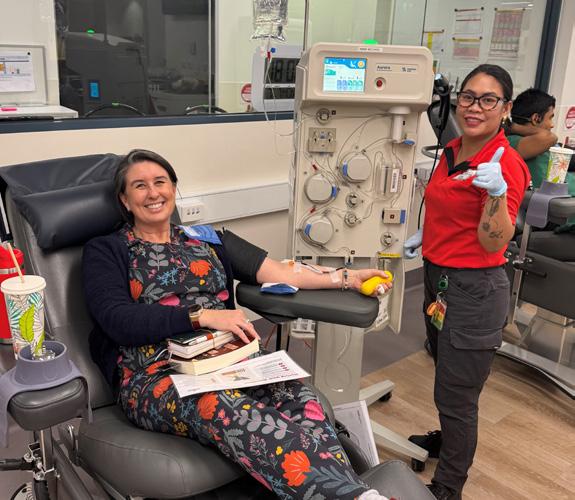
Salaried medical practitioners are still waiting on the Fair Work Commission (FWC) to make a Workplace Determination providing for salaries and conditions of employment. AMA and ASMOF took the matter to the FWC in March after negotiations with the ACT Government became deadlocked. However, it appears that the Full Bench has made little or no progress on the decision since June 2025.
It is disappointing that we continue to wait for an outcome, even as we commence negotiations for the next agreement. Now is the time to identify what is most important to you in the next negotiation and make sure that your voice is heard. Members are encouraged to contact our Senior Workplace Relations Advisor Greg Schmidt on 6270 5418.
The AMA welcomes Janet Zagari into the position of CEO of Canberra Health Services. Janet was a renal nurse before moving into hospital management, moving from Perth and putting down roots in Canberra. Janet has already opened her door for regular dialogue with me and has been taking steps to address matters raised by our team. We note that
she has committed to improve safety, quality and transparency within the hospital system. We would like to thank Dave Peffer for his dedication to the Canberra Health Services during his time as CEO, and wish him well in his new portfolio.
We recently met with Ahpra and the medical board to talk about a range of matters. Thanks to feedback from our members we were able to speak to the personal impact of prolonged investigations on doctors and advocate for improvements to the process. Ahpra renewals are due at the end of the September. Ahpra has asked us to remind everyone that there is a new two-factor authentication process and we encourage you to ensure that this is set up ahead of the deadline. As you complete your registration, please consider completing the Medical Training Survey if you are a junior doctor. The annual results of this anonymous and confidential survey are becoming increasingly powerful as an advocacy tool to drive improvements in medical training. The stronger the data-set, the greater the impact. So please, if you’re a junior doctor, set aside 15-minutes to complete this survey that’s helping make a difference.



The President, Dr Kerrie Aust, Board members and staff of AMA ACT extend their sincere condolences to the family, friends and colleagues of Dr Kenneth Goard and Dr Denise Goard




Two much-loved members of the Canberra medical community received worthy recognition at the National Conference of the Australian Medical Association, AMA25, in Adelaide in August.
Professor Walter Abhayaratna, AMA ACT President from 202124, was admitted to the AMA Roll of Fellows
in recognition of his outstanding leadership in health research and advocacy – particularly his work addressing workforce culture, funding constraints, and COVID19’s impact on the medical profession. His colleagues praised his ability to bring people together whilst never being afraid to “speak truth to power” on matters of importance.
Dr Marrwah Ahmadzai, Obstetrics and Gynaecology registrar

at Canberra Health Services, received the AMA’s Doctor in Training of the Year Award for her outstanding work in women’s healthcare, the provision of culturally safe healthcare, and her work to stamp out racism in our healthcare system.
Among her many achievements, Dr Ahmadzai was the medical lead in the ACT’s first public antenatal education program specifically designed for women
with limited English language proficiency. She has participated in health promotion in the Muslim community by giving talks on women’s health in Ramadan to her local mosque community and online. She has also collaborated with Jean Hailes for Women’s Health to develop guidance for clinicians working with culturally diverse communities in sexual and reproductive health.
Other Award Winners
Women in Medical Leadership Award
Dr Kim Loo and Dr Pramudie Gunaratne
Dr Loo has shown remarkable dedication to addressing climate change’s health impacts, whilst Dr Gunaratne has advocated for stronger public mental health systems amid workforce shortages.
Women’s Health Award
Dr Dominic Edwards
From volunteer work in Uganda and Cambodia to policy development and clinical mentoring, Dr Edwards’ dedication to respectful, comprehensive care has empowered communities and inspired the profession.
Excellence in Healthcare Award
Adjunct Professor Tony Rahman
Professor Rahman’s work combines clinical excellence in gastroenterology with compassionate outreach to marginalised communities.
Dr Rebecca Healey
Dr Healey’s groundbreaking research on international medical graduates is driving important conversations about systemic barriers and discrimination in Australian healthcare.
The President’s Award
Dr Rajeshwary (Raji) Krishnan
Leading a multidisciplinary team at Pramana Medical Centre in Perth, she provides wraparound care to over 6,500 patients — 65 per cent First Nations people — exemplifying holistic, barrier-free healthcare.
AMA Gold Medal Award
Dr Tony Bartone and Dr Omar Khorshid
MD, MSpMed, FRACS, FAOrthA
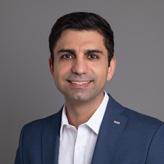
Dr Masoumi joined Orthopaedics ACT in June 2025, taking over the practice of A/Prof Chris Roberts following his retirement.

Shoulder:
› Shoulder Replacement
› Arthroscopic Rotator Cuff Repair
› Sport Injuries
Both leaders guided the profession through Australia’s worst health crisis in 100 years, the COVID-19 pandemic. Indigenous scholarship reaches
› Arthroscopic Shoulder Stabilisation
Hand/Wrist/Elbow:
– page 15
› Nerve Compression, Arthritis, Tumours & Tendinopathies
› Endoscopic Carpal Tunnel Release
› Base of Thumb Arthritis
› Dupuytren’s Contracture
› Elbow and Wrist Arthroscopic Surgery
› Trauma and Reconstructive Surgery Dr Masoumi treats upper limb conditions, including;

Salary package your everyday living costs and eligible benefits, and you could save thousands a year in tax. Think rent, school fees, mortgage repayments, and even dining out with family and friends.
Maximise your take-home pay with expert support
Our medical accounting specialists will help you:
Maximise your entitlements while staying compliant
Avoid common mistakes that could cost you at tax time
Choose the right mix of benefits based on your income and lifestyle
Set up and manage your salary packaging efficiently year-round
With expert advice tailored to medical professionals, you can keep more of what you earn and spend less time worrying about the fine print.
Claim your complimentary consultation with our dedicated

AMA ACT welcomes the creation of an independent inquiry into the ACT public health system, following a joint motion passed by the Canberra Liberals and the ACT Greens.
The inquiry, which will be required to report by 30 June 2026, is set to provide greater transparency on a range of important issues, from outpatient waiting times to the true impact of planned care reforms.
Canberra Liberals leader Ms Leanne Castley MLA told the Assembly it was rare for the Liberals and the Greens to agree

on something wholeheartedly, “but when it comes to the state of our health system, we do”.
“All the feedback and evidence that I know we both have heard means something is wrong, and we must act.”
Ms Castley claimed the ACT public health system was beset by “secrecy” and a “lack of transparency”.
“Highly skilled medical professionals are concerned about a system that forces them to put processes and numbers above the proper treatment of patients, and they are afraid of speaking up,” she said.
Greens leader Mr Shane Rattenbury MLA told the Assembly that throughout this term he had become “increasingly concerned about the increase in demands on acute healthcare services”.
“We know that, between July and December 2024, emergency department presentations increased by 7.6 per cent, while overnight hospital admissions grew by 8.8 per cent. This is a much larger increase than any other jurisdiction in Australia.”
Mr Rattenbury said he believed the inquiry would help put puzzle pieces together to explain what is driving the trends in demand for health services.
The inquiry will investigate:
required improvements to the health data currently made publicly available including, but not limited to, wait times for specialist appointments;
inter-jurisdictional comparisons of publicly available health data;
centralising the publication of health data;
required improvements in the presentation of data to demonstrate longitudinal comparison, changes, and segmentation to demonstrate determinants;
the extent and impact of any interference—administrative, managerial, or political—in clinical care decisions;
current and projected resourcing needs (workforce, theatres, equipment, and beds) relative to demand;
system through engagement with clinical research. They foster the kind of positive training environment that makes medical students want to stay in Canberra for postgraduate training and employment. However, with both the ANU and CHS in deep financial crises, senior clinical leadership positions have fallen by the wayside in recent years, with roles not filled after people move on.
Professor Mitchell said the return of these roles was great news for the medical program and for Canberra’s health system more generally.
“We’ll have more voices working to ensure Canberra has an impactful academic health service that attracts and retains a quality medical workforce and provides the highest quality of care to patients,” she said.
ANU reaffirms commitment
Professor Paul Fitzgerald, Director, School of Medicine and Psychology, ANU told Canberra Doctor the ANU
medical program is a critical part of the health ecosystem in the ACT and the surrounding region.
“The program trains the majority of local graduates who enter work in the health system in the local region and helps attract doctors from other parts of the country and around the world to work here,” he said.
“The commitments that the university has made will ensure that the program thrives, that we can continue a major program review and restructure, and that we can invest further in training graduates who will be committed to working in the ACT and Southeast NSW.”
ANU Vice-Chancellor Distinguished
Professor Genevieve Bell said the ANU has a proud history of training top medical practitioners to support health services for the ACT and beyond.
“We are committed to the medical program and we are excited about the opportunity to revitalise it within the new College of Science and Medicine.”
inter-jurisdictional comparisons of drivers of waiting-list growth, including referral pathways and peri-operative capacity constraints;
factors affecting recruitment, retention, and morale of medical, nursing, and allied health staff;
the effectiveness, risks, and unintended consequences of the planned care reforms and the Digital Health Record implementation, including potential improvements in data, updates to privacy legislation, and oversight required to facilitate patients’ treatment;
concerns raised about cardiology and orthopaedic surgery groups in the ACT public health system.
drivers of waiting-list growth, including referral pathways and peri-operative capacity constraints;

We are excited to announce the opening our new collection centre in Dickson.
Suite 2, 151 Cowper St, Dickson (Two doors up from our existing Dickson location) Open 7.30am to 6pm Monday to Friday 7.30am to 12pm Saturday P 6285 9415
Appointments available all day. Patients can visit capitalpath.com.au/appointments to make an appointment.


PROFESSOR PAUL FITZGERALD Director, School of Medicine and Psychology, The Australian National University
In late May senior ANU management made publicly available the findings of the Nixon review into gender and culture issues in the former ANU College of Health and Medicine and its three constituent schools, the School of Medicine and Psychology (SMP), the John Curtin School of Medical Research (JCSMR) and the National Centre for Epidemiology and Public Health (NCEPH). The report has attracted considerable attention, including in the
last edition of this publication, some of which – perhaps not unsurprisingly – has somewhat misrepresented what the review found. Here I intend to make some observations on the review and its findings, especially from the perspective of the SMP and the medical program.
To understand the findings, it is important to consider the nature, context and timing of the review. First, the review process was established before the disestablishment of the ANU College of Health and Medicine, but conducted after the disestablishment was announced. There are very strongly worded headline findings, which have attracted considerable attention, but the subsequent recommendations are predominantly focussed on the university as a whole, rather than on specific areas, schools or the college. In regard to the SMP, there are very limited references to our school in the report text making it difficult to infer much at the medical program level. Second, while a significant number of former college and current school members were interviewed or submitted written statements, for practical and design reasons, only a minority of staff were engaged. The review did
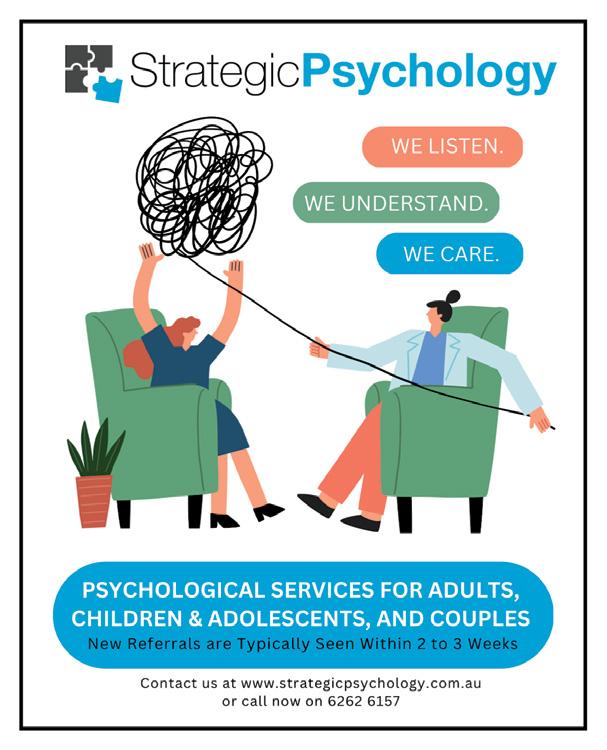
not entail an extensive review of our school processes, programs or culture. However, much of the adverse publicity arising from the report has identified the medical program in some way as the source of the issues: for example, with headlines referencing ‘ANU Medicine’ or ‘ANU med’ alongside statements about ‘poor and disrespectful culture’ and prevalent ‘gender bias, sexism and racial discrimination’. As such, I believe that the SMP and our medical program has been unfairly although most likely unintentionally, targeted. The major findings of the review are not entirely irrelevant to SMP, but the report rarely mentions the medical program, our staff, or our students. In fact, when describing culturerelated issues, the review noted that staff perceived these to exist ‘across the College and the broader University’.
The report did identify serious concerns, and the university has committed, appropriately, to address these proactively and transparently. The report identified issues with culture, gender and racial biases and other forms of discrimination. As noted though, the majority of the recommendations in the report relate to wider university policies and procedures. For example, complaints management, providing appropriate leadership and management training for academic staff, improving performance management and the monitoring and reporting of workload and less traditional outcomes of academic activity, such as HDR (Higher Degree by Research) student progression, are all processes that occur outside of programs and schools. None of this means we should dismiss the findings of the report or fail to actively engage with its findings, or that we don’t have issues in the SMP or the medical program. Rather, that it is unfair to lay all, or the majority of the issues, at the feet of the people of the SMP. Since the establishment of the SMP, we have been committed to actively addressing cultural issues within the school. At the inception of the school, we appointed an Associate

Director of Culture and Wellbeing: I am not aware of other schools with this type of leadership role. We have ingrained culture-related strategies within the SMP strategic plan such that culture and wellbeing are considered of equal significance to our educational and research initiatives. We are committed to a transparent annual school survey of culture and well-being, with a committee developing initiatives from the survey findings. For example, meaningful changes to our school meetings and communication approaches were implemented in response to learnings from the 2024 survey. Consistent with this commitment, the SMP executive have looked at the findings of the report in-depth, are consulting with staff and students, and are planning how we can improve processes and activities in the school, as well as engage in the ANU Nixon Review activities addressing university-wide problems. The report did highlight an issue of the precarity
We will continue to advocate for increased funding of the school to address this longrunning issue as well as explore novel strategies to increase our funding base.
of funding for the medical program and the SMP more generally and the workload implications of this for our staff. We will continue to advocate for increased funding of the school to address this long-running issue as well as explore novel strategies to increase our funding base. It is also very important to note that ANU has already established a comprehensive process to address all of the recommendations of the
review, to engage staff in this and to ensure there is accountability, with Prof Nixon to return twice in 2026 to review progress. I cannot end without highlighting one issue raised in the report which was solely SMP focussed. Under a clause in the terms of reference which allowed the reviewer to make recommendations without any constraint, a recommendation was made to ‘consider reestablishing Psychology as an independent research school within the College of Science’. The decision to merge the Medical School and Research School of Psychology occurred prior to my appointment at ANU and so I cannot speak first-hand to the processes this entailed but concerns around a lack of consultation in the process and a loss of discipline identity, leadership and representation were made. I would add to this that the deterioration of the university financial situation has significantly impacted our capacity to genuinely bring the two halves of the school together, including the university’s cancellation of plans to co-locate all school staff and students. This recommendation will be addressed in the coming months via a process to be led by the Dean of the College of Science and Medicine.
Ultimately the Nixon review has been a wakeup call for ANU. The review lead, Professor Nixon, has noted in several staff forums that many of the issues identified are sector wide problems, but this does in no way diminish our responsibility to address them locally. I am hopeful that the response of the university, and what we can do within the SMP, will ultimately be to the benefit of our staff and students.

In Canberra Doctor’s previous edition we asked readers what they would do with a magic wand to solve the Wicked Problems our health system is facing.

BY DR LIZ FRAZER
MBBS MEd FRACGP Watson General Practice
The Wicked Problem
The long-term starvation of general practice Medicare rebates means that many practices cannot afford to bulk-bill all patients, even those with low incomes. Recent miserly increases in rebates and fiddling with the Medicare system are insufficient for many GPs to consider increasing bulk-billing.
As a GP with a social conscience, I have done plenty of bulk-billing, sacrificing between 40 and 60%
Wicked Problems are resistant to solutions because their sheer complexity makes it extremely difficult to reach agreement on where to start. These problems require fresh thinking and fearless collaboration. They require Wicked Solutions.
Dr Liz Fraser of Watson was up for the challenge. Here’s her Wicked Solution to solve the general practice affordability crisis. For her efforts, she’s received a $200 Escape Rooms Canberra voucher.
Disclaimer: The AMA does not endorse any of the views that are put forward as part of this feature.

of my income to make quality health care accessible to those inhabiting the margins of society. As a survivor of the sudden closure of Hobart Place General Practice in 2023, I’m now dedicated to private billing. But my social conscience still screams at me because I know that some patients experience financial hardship.
The Wicked Solution
Given that many GPs sacrifice income by bulk-billing, let’s acknowledge that they are in effect making a donation to the welfare state. Every time a GP bulk-bills, they subsidise the government and save the national health budget. By calculating the difference between what GPs might reasonably charge (e.g. the AMA standard fee)
and Medicare rebate (plus any relevant incentives), and adding this difference up over a financial year, we would truly measure the generosity of GPs. This donation should be taxdeductible for GPs. This would require an organisation that has the status of a deductible gift recipient (DGR). Because the government is the recipient of GP charity, the DGR would need to be set up by and represent the government. Medicare can already tell us exactly how much a GP obtains from bulk-billing Medicare. It shouldn’t be difficult to set up a system that tracks the value of GPs’ charity when we forego a private fee. At the EOFY, the DGR can use these figures to issue a receipt for GP donations to the welfare of the nation. This system would undoubtedly
After years of advocacy, ACT GPs with a special interest in ADHD will soon be able to diagnose the condition in young people and prescribe appropriate medication.
The ACT Government has confirmed that work is underway to design an ADHD GP pilot, with aims for it to commence by the end of this year, consistent with a parallel policy in NSW.
“We will be seeking to capture as many interested GPs as possible in the pilot,” an ACT Government spokesperson said. GPs are now being invited to express an interest in ‘diagnosis and prescribing’ or the ‘prescribing only’ stream. (See link at bottom of article). Currently only paediatricians, neurologists and psychiatrists are allowed to diagnose and treat
the condition, meaning many patients are left waiting months, or even years, for a diagnosis.
AMA ACT President Dr Kerrie Aust said the coming pilot would bring relief to young people and families experiencing the stress of undiagnosed and untreated ADHD.
“There are many GPs in Canberra who been calling for this change for several years, and who are ready for it,” Dr Aust said. “We have a well-established community of GPs with a special interest in ADHD here in the ACT, including 60 GPs who meet regularly with support from psychiatrists, paediatricians and other non-GP specialists to support safe management of ADHD.”
“While psychiatrists and paediatricians have really been trying to step up to address wait times, this is a good example where GPs can work to the full breadth
of their scope and get involved in the diagnosis and management.
"We know that providing access to holistic care for young people with ADHD makes a difference in their capacity to attend school and work, their relationships and their health.”
GP Dr Wee-Sian Woon, who co-founded and convenes the GP ADHD Special Interest Group with fellow GP Dr Annie Lim, said the group has grown rapidly since its launch in early 2024.
“We now have around 60 GP members from the ACT and surrounding regions,” he told Canberra Doctor. “Our last session, just a few weeks ago, was an engaging and practical session with local cardiologist Dr Siang Soh on stimulants and heart health.”
Dr Woon said ADHD is a chronic condition that should be better integrated into primary care, where



benefit many female GPs who carry the burden of poorly paid long consultations with people who have complex health problems and low incomes and who are thus more likely to be bulk-billed. For some GPs, the extent of their donation might drop their taxable income into negative territory.
I first made this suggestion in a letter to the editor of Australian Doctor many years ago. It didn’t make it into public policy back then; here’s hoping. If religious organisations can obtain tax exempt status, then surely the generosity and good works of Australian GPs can be quantified, acknowledged, and given a tax-break.

most people first seek help. “Diagnosis can be complex because of overlapping symptoms of other conditions and cooccurring conditions,” he said. “But GPs can be well placed to play a greater role, given our long-term relationships with patients and long-term knowledge of their medical history. It will require robust upskilling for interested GPs, as well as ongoing support and discussion with paediatricians
and psychiatrists for more complex cases if required. I look forward to seeing how ACT Health implements its planned training and education program.” Queensland has had a similar system in place since 2017 for patients aged between four and 18, while New South Wales, Western Australia and South Australia have also committed to rolling out a GP-led ADHD program for young people.
To express your interest go to forms.office.com/r/XLHy54jEVk


GABRIELLE SULLIVAN
Sullivans Legal Co
Many doctors may have come across ‘restraint of trade’ or ‘restrictive covenant’ clauses in employment contracts, facility services agreements or sale of business contracts. When a doctor moves on, these clauses aim to protect practice owners from losing patients, staff or proprietary knowledge.
While sweeping reforms to restraint of trade clauses announced by the Albanese Government mean the legal landscape is shifting, these clauses will remain relevant to medical practitioners. Understanding what these clauses mean, their enforceability, and what the future holds, remains important.
In a nutshell
Restraint of trade clauses can restrict future job mobility, but their enforceability is not guaranteed and depends on their reasonableness and specific circumstances.
The Australian Government has announced reforms to ban most non-compete clauses for workers earning below the high income threshold (currently $183,100), set to begin in 2027.
Restraint clauses still have real implications for medical businesses and their workers.
trade clauses?
A restraint of trade clause restrains various activities of the promisor after the cessation of
their relationship with the promisee. Typically, they take the form of restrictive covenants that are either ‘non-compete’, ‘non-solicitation’ or ‘non-poaching’ clauses.
In medicine, ‘non-compete’ clauses prevent doctors from working for a rival practice or starting their own within a set region and time frame. They aim to protect business interests such as confidential patient lists and established goodwill.
‘Non-solicitation’ clauses in contrast, do not bar competition outright, but prohibit doctors from actively encouraging patients to follow them when leaving. These aim to help practices retain their client base.
‘Non-poaching clauses’ are similar to ‘non-solicitation’ clauses, but they are directed at protecting a stable workforce base, rather than customer base.
Typically, all such clauses specify certain postcodes or areas, and last from a few months up to several years beyond termination.
Do these clauses work?
The starting point is that if there is no restraint of trade clause, once a contract has ended, parties are generally free to move on and do as they please (subject to obligations to maintain certain confidences). However, if the parties have voluntarily entered into a contract that includes a restraint of trade term, courts are obliged to uphold the bargain as struck between the parties.
The common law has traditionally been reluctant to allow courts to uphold restraint of trade clauses, because at their heart they are anticompetitive, and limit a worker’s mobility and ability to earn a living in the short term. Enforceable restraints have been limited to only those that are reasonably necessary to protect a ‘legitimate protectable interests’, such as an interest in retaining patients, staff or confidential information. A mere interest in not having to face a new competitor is not a legitimate protectable interest.
So, post-termination restraint clauses can be difficult to enforce. But this is not to say they cannot be enforced at all – particularly if they have been carefully drafted. Although restraint disputes involving doctors that reach courts are rare, by way of example, a 2015 interlocutory injunction in Victoria

was awarded in the case of Epichealth v Yang [2015] VSC 516 to enforce a non-compete clause. The court ordered the doctor to not practise within a defined geographical area for about 4 months post termination.
On 25 March 2025, the Federal Government announced major changes to competition in the labour market. It is moving to ban non-compete clauses for most workers who earn under the high income threshold (currently $183,100 a year). Subject to consultation, the reforms are set to take effect from 2027.
For doctors and their staff earning under the income threshold, future contracts are unlikely to include enforceable non-compete clauses. However, non-solicitation and non-poaching clauses are not currently included in the planned ban and may still operate — provided they remain reasonable and valid on application of the established legal tests.
What does this mean?
For employers and practice owners, thoughtful application of restraint of trade clauses will become more important. Non-compete clauses are set to disappear for lower paid employees, making it important to ensure customers, patient
and staff relationships, and confidential information are appropriately protected by other means. In relation to those above the high-income threshold, it will continue to be important to review contracts to ensure restraint clauses are drafted carefully to maximise their chances of enforceability. For employees or contractors, doctors should be aware courts can and do enforce reasonable restraints. So, when offered a contract, negotiating the scope of restrictive covenants remains key. When changing clinics or starting in a new practice, or considering asking your colleagues to leave with you, take a look at your contract first. In either case, seeking legal advice to ensure terms are ‘reasonable’ might be advisable.
In summary, the impending legislative reforms signal a change in policy direction, but are unlikely to have a significant impact across the medical profession because of their focus on lower income employees. Further, to the extent Canberra practitioners have more patients than they
can manage, skirmishes over retaining patients might be largely irrelevant in the ACT. However, there are parts of the market where restraints of trade will remain relevant, particularly with any market shift away from GP-owned and solo practices, towards corporate and ownership models. The laws and their application can be complex, so legal advice in this area is particularly advisable.
Gabrielle Sullivan is Managing Legal Practitioner and Director at Sullivans Legal Co, and a Law Society Accredited Specialist in Employment & Industrial Law www.sullivanslegal.com.au. Gabrielle acknowledges the assistance of Alistair Davidson in writing this article.
The content of this article is intended to provide a general overview on a matter of interest. It is not intended to be comprehensive. It does not constitute legal advice and should not be relied upon as such. You should seek legal or other professional advice before acting or relying on any of the content.

On behalf of all doctors in the Canberra region, AMA ACT extends our condolences to the family, friends and colleagues of long-serving CHS Switchboard team member, Celia JulianBailey, who passed away on 24 July.
Celia was part of the Switchboard team for over 20 years, and was known and loved by many health professionals across Canberra. Dozens of doctors have sent memories to Celia’s family, recalling her warmth and wit, and the way she put them at ease in stressful situations.
Celia had an uncanny knack for recognising doctors’ voices before they’d even said who was calling, having known many of them since their JMO days. She would affectionately greet them as “darling” or “love”, ask about
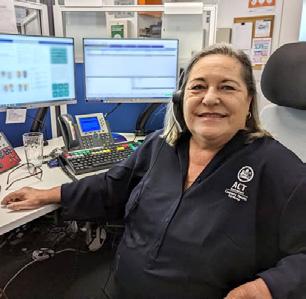
their families, and often share a selfdeprecating joke or a commiserating sigh before getting down to business.
In a system that’s constantly changing, Celia was a reassuring constant with her calming voice and no-nonsense attitude.
Junior doctors described how they would call her for advice, and how she would give them a break from their pager so they could go to the bathroom or get lunch.
As one doctor wrote: “There was much magic about her, and she made a lasting impression on my life.”
Farewell Celia. You will be deeply missed.

Do you know someone who could benefit from temporary government-funded support with daily living?
The Community Assistance and Temporary Supports (CATS) program is funded by the ACT Government to provide practical, time-limited assistance to people who are unwell or functionally impaired and waiting to access NDIS or My Aged Care supports. Services include help with daily living, transport, meal preparation, and social support, and are designed to maintain safety and independence during the waiting period.

Providers under the program include:
ACT Disability, Aged and Carer Advocacy Service
Anglicare
Capital Region
Community Services
Carers ACT
Community Services #1
Life Without Barriers
Northside Community Service
Nish Mohan, General Manager (Operations) of Northside Community Service said despite
Further details available at qrco.de/bgFtHk

Let’s cut to the chase with your salary benefits: Your salary package includes your base salary, superannuation and fringe benefits. By ‘sacrificing’ part of your salary for fringe benefits or extra super contributions, you can lower your taxable income and keep more of your money in your pocket.
So, what can you claim?
If you work for a public hospital or ambulance service in ACT, you may be eligible to salary package non-cash benefits without attracting Fringe Benefits Tax (FBT).
These benefits can include:
Everyday living expenses – up to $9,009 of general living expenses, such as mortgage repayments, rent, credit card payments or school fees
Exempt benefits – like work-related laptops or mobile phones
Additional savings through Meal Entertainment
Meal Entertainment is an additional benefit that allows eligible employees to claim up to $2,650 per annum on certain food and drink expenses. Best of all, this sits outside your $9,009 cap and does not appear on your payment summary.
Eligible expenses include:
Dining out at cafes or restaurants with family and friends
Meals and drinks enjoyed while travelling, including overseas
Catering for private functions (think weddings, birthdays, anniversaries) However, there are a few things to keep in mind – you can’t claim:
Alcohol without a meal
Takeaway or meals consumed at home or work
Meals where you’re dining alone
Events where food isn’t the primary purpose
Claims under $15 (generally not accepted)
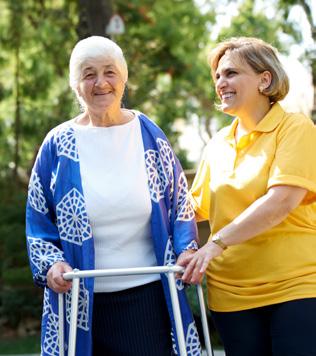
its relevance, the program remains under-utilised—largely due to low awareness among healthcare professionals.

“Clinicians regularly working with patients experiencing service delays may find this program to be a valuable interim support option,” he said.
“Case managers work with each client to identify the services that best meet their needs. All services are fully funded by the ACT Government, so clients pay nothing out of pocket.”

Using a meal entertainment card
You can use a dedicated Meal Entertainment Benefit Card, which works much like a Visa debit card –but specifically for eligible expenses.
A few things to note:
Any unused funds are refunded (minus PAYG tax)
Receipts should be kept in case of audit
Misuse may lead to the cancellation of the card

Maximising your salary benefits can put more money in your pocket, but it needs to be done right! Book a complimentary consultation with our medical accounting specialists today.
Call 1800 988 522 or visit cutcher.com.au

NESH NIKOLIC Strategic Psychology

When a child is identified as neurodivergent, the focus often narrows intensely onto that child’s needs. While this is understandable, it can inadvertently overlook the broader family system, which is both impacted by and instrumental in supporting the child’s wellbeing.
Rather than viewing the neurodivergent child in isolation, a family-systems approach considers the family as a dynamic, interconnected unit. Every family member affects, and is affected by, the others. When a child struggles, parents may become exhausted, siblings can feel neglected and routines are often disrupted. These changes, if left unaddressed, can strain relationships, affect mental health
and reduce the family’s overall capacity to cope. In practical terms, a family-systems approach means asking questions like: How are the parents coping? How is the sibling adjusting? What supports does the family have? It also involves identifying where stress and resilience live in the system. For example, one parent may be the emotional anchor but is close to burnout; another may feel disconnected or unsure of how to help.
Encouraging families to access systemic support—such as parenting programs, family counselling or respite services—can improve the overall functioning of the household. When parents are supported, they’re better able to regulate, problemsolve and connect with their neurodivergent child. Siblings who feel seen and heard are more likely to develop empathy and resilience, rather than
resentment or anxiety. This approach doesn’t replace individual therapy or developmental interventions; it enhances them. It recognises that a child’s success is deeply tied to the emotional climate around them. If that climate is strained, no amount of individual therapy will be enough. But when families feel strong, cohesive and supported, the child is far more likely to thrive.

A new purpose-built private hospital has officially opened in Deakin, delivering advanced day surgery and specialist procedures to meet the growing healthcare needs of Canberra and surrounding regions.
The ACT Day Hospital, established by Dr Romil Jain and his team at the ACT Pain Centre, expands an integrated network of healthcare services already located on-site at Geils Court in Deakin. This includes the Canberra Child Psychiatry Centre and the ACT Specialist Centre, which hosts a wide range of medical specialties including renal medicine, oncology, gynaecology,
psychiatry, haematology, rheumatology, general surgery and neurosurgery.
This multidisciplinary environment is further supported by a team of allied health professionals— physiotherapists, exercise physiologist, clinical and health psychologists, an occupational therapist and a dietitian—ensuring patients benefit from coordinated, holistic care across disciplines.
The hospital features two fully equipped, modern operating theatres, including a floor-mounted angiography suite designed specifically for advanced interventional pain procedures. This suite also allows for select cardiovascular interventions that are not typically offered in a day hospital setting.
The facility was officially opened on 6 June by ACT Minister for Health Rachel Stephen-Smith. At the
Neurodivergent children often evoke strong emotional responses in caregivers—frustration, guilt, anxiety. These reactions are not just about the child’s behaviour but are embedded in the family’s emotional system. Supporting parents in managing their own reactivity can lead to more effective parenting and improved child outcomes.
Parents may unconsciously project their anxieties or unresolved issues onto the neurodivergent child—intensifying the child’s challenges. Clinicians can explore these dynamics and help parents differentiate their own emotional experiences from their child’s needs.
Helping family members—especially parents— develop greater emotional autonomy (differentiation) allows them to respond to the child’s needs with clarity rather than emotional fusion. This is crucial in navigating the often unpredictable and demanding nature of neurodivergent care.
Neurodivergence often runs in families. A parent with undiagnosed ADHD or autism may struggle with executive functioning or emotional regulation, impacting their parenting. Clinicians can explore family history and identify patterns that may influence current dynamics. These concepts are based on the work of Family Systems Theory pioneer Dr Murray Bowen.
launch, Dr Jain—specialist in pain medicine and interventional pain— shared that the hospital and associated entities currently has approximately 80 staff and clinicians, with plans to increase to 100 in the coming months.
Dr Jain also announced that facio-maxillary surgeon Dr Michael Cooper has commenced work at the hospital, with additional services in gynaecology, ophthalmology, neurosurgery and general surgery scheduled to launch soon.
“Our goal is to provide timely, efficient, and affordable surgical services to the community,” Dr Jain said.
The hospital is expected to accommodate an average of 40 procedures per day, significantly improving access to care across the region.
Teen vaping has ‘turned a corner’
The AMA has welcomed new data showing a significant decline in vaping rates among Australian teenagers, describing the findings as a “turning point in youth health” and a testament to the power of strong policy, education, and community awareness. Data released by Health Minister Mark Butler in July shows vaping rates among children aged 14–17 years have fallen from 17.5 per cent at the start of 2023 to 14.6 per cent in April this year. The figures are drawn from the Cancer Council’s latest Generation Vape research, which is considered the most comprehensive survey

on vaping in Australia. The “eighth wave” of data includes responses from about 3,000 young people and shows a broader decline in vaping across all age groups. The AMA reaffirmed its commitment to supporting evidence-based strategies to reduce youth vaping and smoking, and called for continued vigilance as new products and marketing tactics emerge.

DR BETTY GE
AMA ACT Board & Medical Women's Society - ACT
The Medical Women’s Society ACT’s Education Night on 5 August was a valuable opportunity for colleagues to learn and share on the critical topic of healthcare delivery in low-resource settings.

Dr Karima Hamed Faryabi, a medical pioneer and former Minister of Economy of Afghanistan, delivered a deeply moving and inspiring presentation on her leadership in public health, women’s empowerment and medical service delivery in politically fragile environments. Drawing from her work with Médecins Sans Frontières (MSF) and her personal journey, she emphasised the importance of empowering local communities to take ownership of healthcare delivery. She

also spoke about strategies for building resilient health systems amid political instability.
Dr Faryabi survived three assassination attempts, underscoring the personal risks faced by those who challenge systemic injustice. Her story resonated deeply with attendees, highlighting the intersection of courage, compassion, and clinical excellence.
Dr Elizabeth Gallagher, an obstetrician and gynaecologist, shared her experiences supporting advanced gynaecological surgical
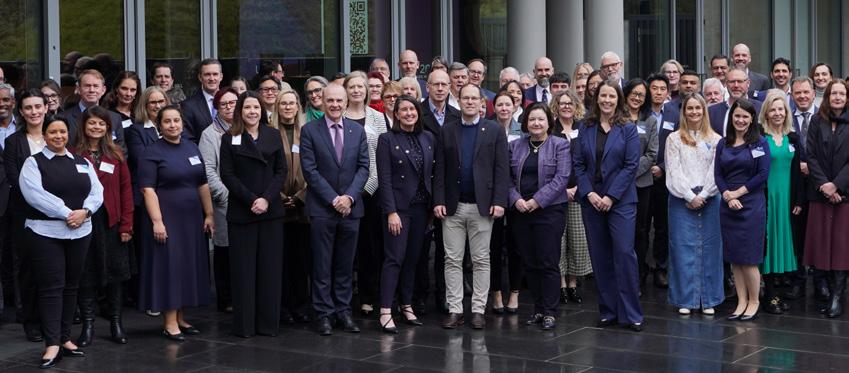

More than 50 medical groups attended AMA’s national meeting of medical colleges, associations and societies in Canberra on 23 June, with Health Minister Mark Butler also addressing the meeting.
AMA President Dr Danielle McMullen told the meeting reform was urgently needed across multiple facets of the health system.
“Australia’s health system is under immense strain — from the logjam crisis in public hospitals; rural communities struggling to access care; and the shuttering of private hospitals and services,” Dr McMullen said.
AMA ACT President Dr Kerrie Aust spoke on the topic of Scope of Practice in Primary Care, warning about the problems of “focusing on disease models rather than diagnosis”, the lack of robust evaluation of experimental programs, and the danger of de-valuing the medical voice at a time of rampant medical misinformation.

procedures in the Solomon Islands. Her presentation offered a compelling look into the realities of working in a low-resource hospital setting, with limited access to surgical equipment and anaesthetic support.
Dr David O’Rourke, an obstetrician and gynaecologist, shared a deeply personal and emotional account of his journey to establish a maternity hospital from the ground up in West Timor. He emphasised the importance of community trust and local leadership and collaboration in sustaining healthcare services.
Dr O’Rourke also gave a heartfelt tribute to his late colleague, Dr Peter Scott, an obstetric colleague whose dedication and compassion left a lasting legacy in the region. Dr O’Rourke’s story served as a powerful reminder of the human spirit behind medical service and the enduring impact of collaborative care.
To Join the Medical Women’s Society or find out about future events visit act.afmw.org.au

PBS update:
Services Australia is expanding Online PBS Authorities, requiring doctors to document patient baseline values and previous treatment failures to demonstrate continued eligibility for complex authority required programs.
Access to PBS-subsidised medicines is critical to patient care, which is why Services Australia continues to expand the Online PBS Authorities system. Currently, for written Complex Authority Required
programs such as Rheumatoid Arthritis and Crohn’s Disease, Services Australia collects information about patient history and treatment targets. As remaining written Complex Authority Required programs move to the online system, you may need to provide previously supplied information in your applications. This includes re-stating baseline values from initial applications to demonstrate ongoing eligibility. Services Australia recommends you start documenting your patients' baseline values and previous treatment failures in their medical records now, in preparation for these changes.
To apply for PBS Authority go to servicesaustralia.gov.au/apply-for-pbs-authority
Snezna Schmidt, PhD student at the University of Canberra in the Science and Technology and Health faculties is seeking participants for a study investigating how older Australians with mild cognitive impairment use technology.
The information will be used to help design technology solutions for older Australians with mild cognitive impairment which are useful and easy to use.
Participant selection criteria:
Older people with mild cognitive impairment
Over 65 years
Living in the community
Family members of older people with mild cognitive impairment
Medical practitioners who treat older people with mild cognitive impairment
Research activities

Participants will receive information about the research and all activities before they are asked to provide consent. If consent is provided, participants will attend an interview at the University of Canberra which will last approximately 1 hour. Participants will also be able to choose to take part in a group activity at the University of Canberra, which will last approximately 1.5 hours and/
Rui Yang, a second-year medical student at the Australian National University, is conducting a research project on the impact of Large Language Model tools—such as ChatGPT—on the Australian healthcare system. The study focuses on how doctors are using these tools and the potential influence on
Dr Hazel Serrao-Brown
the doctor–patient relationship.
All Australian doctors are invited to participate in the study, which aims to collect their perspectives on the LLM tools used, reasons for use, patterns of use, perceived concerns and overall satisfaction.
To complete the survey, please visit the link or scan the QR code.
or an individual evaluation session, which will also last approximately 1.5 hours, if they are interested. The activities will all occur on different days and participants will receive a gift voucher after each activity.
Contact
Please contact snezna.schmidt@canberra.edu.au if you meet the inclusion criteria and would like to participate, are able to assist in identifying participants, or if you would like more details about this research.


https://anu.au1.qualtrics.com/jfe/ form/SV_bCLSKNj1jxTMZH8

Dany Duong, PhD Candidate at the University of Canberra (UC), is conducting academic research into cybersecurity and Australian medical clinics within the greater ACT region. The research has received UC Ethics approval HREC14173.
Dany’s research aims to:
1. capture a baseline understanding of the cybersecurity awareness and process of Australian medical clinics;
2. identify barriers/obstacles to adopting secure cybersecurity practice;
3. analyse our sector’s cyber risk profile;
4. explore opportunities for clinics to adopt more secure cybersecurity practices to assure secure and confidential patient information in the cyber space; and
5. investigate a tailored cybersecurity framework for medical clinics to improve data protection.
All GPs and staff (current and former) of medical practices within the greater ACT region, are cordially invited and encouraged to participate by completing the research survey.
By completing the survey, participants also get the chance to win 1 of 5 prizes. Draw prizes are:
1 x $100 Gold Class movie voucher; 2 x $50 gift cards; and, 2 x $50 chocolates gifts.
Survey URL: https://uoc. syd1.qualtrics.com/jfe/form/ SV_2s1MdripyFhCeuG

Are you new in town? Or has your practice welcomed a new doctor? We’d love to help you get the word out to referring doctors by running a profile in the next edition of Canberra Doctor. It’s easy – just scan the QR code.
Professor Christian Gericke
Dr Hazel Serrao-Brown is an Endocrine & General Surgeon based in Canberra.
She has completed the sub-specialty TS Reeve International Endocrine Surgery Fellowship and is a Fellow of the Royal Australasian College of Surgeons (FRACS). She specialises in the surgical management of thyroid conditions, hyperparathyroidism and adrenal nodules, as well as a variety of general surgical pathologies. Her expertise also includes laparoscopic surgery, hernia repair, excision of skin and soft tissue lesions and endoscopy. Dr Serrao-Brown practices at The Canberra Hospital, North Canberra Hospital, National Capital Private Hospital, Calvary Bruce Private
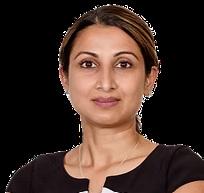
Hospital, Calvary John James Hospital & Brindabella Endoscopy Centre. Her rooms are located at Suite 18, John James Medical Centre, Deakin ACT. Please send referrals to info@canberrasurgery.com.au or call (02) 6282 1200. New patients will be seen within 2 weeks, and can be booked for surgery within 2-4 weeks thereafter. Please visit www.canberrasurgery.com.au for further information.
Professor Christian Gericke has recently established neurology rooms at the Canberra Epilepsy Specialist Centre at Deakin Private Hospital.
Prof Gericke is a Consultant Neurologist and Epileptologist at Canberra Hospital, Calvary Bruce Private Hospital and Clinical Professor of Medicine at ANU. He also serves as Squadron Leader and Aerospace Neurologist in the RAAF and heads the Australian Government's Specialist Medical Review Council.
Previously, he worked as an academic neurologist at Calvary Mater Newcastle, Prince Charles Hospital in Brisbane, King’s College Hospital London, and Sheffield Teaching Hospitals. He is passionate about advocating for better access to modern

antiseizure medications, deep brain stimulation, and access to stroke clot retrieval in regional Australia. He chairs the Australian and New Zealand Association of Neurologists' Therapeutics Committee and serves on the International League Against Epilepsy's Standards and Best Practice Council, as well as the AMA Federal Council. For new patient bookings, please call 02 5114 8229 or visit www.canberra-epilepsy-centre.org
“Mindfulness doesn’t work for me” – Famous last words

BRIGETTE BERRY
Clinical Psychologist
ACT Pain Centre
Mindfulness interventions are everywhere – in apps, in schools, in hospitals. For many, it can significantly improve wellbeing. But I often hear: “I’ve tried it – it doesn’t work for me”.
As a clinical psychologist, instead of taking this at face value, I like to explore why it didn’t work –and when appropriate, encourage a second go. Here are the three most common disputes I see.
1: “I can’t stop my thoughts – I’m doing it wrong!”
Many people picture mindfulness as sitting perfectly still with a completely empty mind. Which sounds nice… until you try it for more than about 10 seconds. This is impossible because your brain is designed to wander. It is normal to having distracting thoughts pop up. Mindfulness is not about stopping thoughts. It’s about noticing them without judgement – and then gently guiding your attention back. I often compare the mind to a puppy learning to walk on a leash. You want the puppy to stay on the path, but it keeps sniffing bushes, chasing leaves and getting distracted. You don’t yell at the puppy – you gently guide it back and reward it for returning. Mindfulness is the same. Notice the mind when it's wandering and guide it back with kindness to the task at hand. Once clients understand this, many feel relieved – and willing to try again.
2: “It didn’t make me feel better, so what’s the point?”
Relaxation techniques (e.g. diaphragmatic breathing, progressive muscle relaxation) are designed to calm you down. But mindfulness has a different goal. Mindfulness

builds awareness of your inner world, which may feel relaxing, but is not the aim. Over time, that awareness typically leads to better emotional regulation and psychological flexibility – but it’s not for instant relief. I often explain this with the emotion regulation “traffic light” from Dialectical Behaviour Therapy:
Green Zone (1–4/10) = lower intensity
Yellow Zone (5–7/10) = building up phase
Red Zone (8–10/10) = higher intensity
Relaxation is typically best for the Red Zone. Mindfulness is typically helpful in the Green and Yellow Zones – when you can observe emotions before they completely spiral. Sometimes effectively managing your Green and Yellow Zones can prevent Red Zones. However, if we want to use mindfulness in our Red Zones we need to practice first. We often believe we’ll rise to the occasion in stressful moments. But we usually sink to the level of our practice. Which means if you want mindfulness to help in all emotion zones, you’ve got to practise it regularly. Often after explaining this, clients are willing to give mindfulness another go, typically starting in Green and/or Yellow zones.

Doctors tap into their creative side at Safe Space 9 Who's looking after you?
3: “It made me feel distressed”
This can happen – especially for people with significant trauma histories. Being asked to “sit with” your internal experiences is often unsafe especially without trauma therapy first. In these cases, mindfulness needs to be prescribed in a traumainformed way. This could look like waiting until the person has more safety before practising, or offering choices throughout the practice, or going slowly. For psychologists, this means extra training and supervision, so mindfulness is used safely.
If you’ve ever said, “mindfulness doesn’t work for me,” it’s worth asking yourself: Were my expectations realistic? Was I practising in the right emotion zone? And regularly? Was it adapted to my needs? Sometimes, mindfulness doesn’t need to be thrown out – it just needs a renovation. With the right approach, it might surprise you how much it can bring to your life.
Brigette presented at Safe Space 9, a wellbeing event for doctors, hosted by AMA ACT for Drs4Drs ACT.

Dr Vida Viliunas, Vice President of the Australian Society of Anaesthetists attended Safe Space 9 and wants to spread the word about future Safe Space events.

“Safe Space 9 was an outstanding Sunday morning of collegiate ideas exchange! A thoughtful combination of topics for busy practitioners who need to stay well to get their to do list done. This turned into a workshop of sharing mindfulness, organisation and productivity tips by the whole group,” Dr Viliunas said.
Drs4Drs ACT offers an independent and free confidential support service run by doctors, for doctors and medical students. We can help with: No problem is too trivial or too serious.

The next Drs4Drs Safe Space event will be on Saturday 18 October at AMA offices in Barton. Events are for all doctors and medical students. For more information visit ama.com.au/act/events

ama.com.au/drs4drs/act

ACT Health is advising health professionals that the ACT Quitline and ACT Quitline for Aboriginal and Torres Strait Islander communities have undergone important changes.
As of 1 July 2025, both Quitline services have transitioned to being provided by Cancer Council Victoria. With this transition most things remain the same, such as the Quitline number remaining unchanged (137 848), the callback service operating as normal, as well as there being dedicated Aboriginal and Torres Strait Islander Counsellors available for all Aboriginal and Torres Strait Islander clients.
There are some service delivery changes:
Digital access options are available, including Webchat, text support, WhatsApp, and Facebook Messenger. Please visit quit.org.au/get-support, where you will find information on how to access each of
these services, including how to request a call back if clients (or health workers on behalf of clients) would like a Quitline counsellor to call them directly.
Referrals from health and other professionals can be sent via the online Quitline referral form at quit.org.au/referral-form. Any previous email addresses or fax machine numbers for Quitline referrals will no longer be active. If you have any issues in referrals to Quitline, or your clients experience issues accessing the ACT Quitline from 1 July 2025, contact ATODPolicy@act.gov.au.
Self-requesting a call-back is available via the QuitHub portal at quit.org.au/request-callback
Service hours have also changed. New hours are 8am – 8pm Monday to Friday. The ACT Quitline services do not operate on weekends or public holidays.

Dany Duong, PhD Candidate at the University of Canberra (UC), is conducting academic research into cybersecurity and Australian medical clinics. All GPs and staff (current and former) of medical practices within the greater ACT region, are encouraged to participate.
Results from the survey will provide insights into current cybersecurity awareness and processes of medical clinics; identify barriers and obstacles to adopting secure cybersecurity practices; and, inform the design and development of a tailored cybersecurity framework, aimed at helping Australian medical practices to better protect their information.
Complete the survey, for the chance to win 1 of 5 prizes!
1 x $100 Gold Class movie voucher;
2 x $50 gift cards; and,
2 x $50 chocolates gifts.
uoc.syd1.qualtrics.com/jfe/form/SV_2s1MdripyFhCeuG
The research has received UC Ethics approval HREC14173.

DR DANIELLE MCMULLEN AMA President
I first discovered a fake social media profile impersonating me when a family member called to ask if I really believed in what I – the fake version – was selling.
I felt a rush of emotions: confusion, concern, and disbelief. How could this be allowed to happen?
All online scams are insidious, but they become particularly dangerous when they involve healthcare. Since discovering the fake Dr McMullen on Facebook, I have made several attempts to have her removed. Unfortunately, my efforts have been futile. It feels like an endless game of whack-a-mole — and the scammers are winning. It seems I got off relatively lightly, though. Other prominent clinicians, including Dr Norman Swan and former AMA president Professor Kerryn Phelps have had their identities misused in “deepfake” videos that promote unproven health products.
The companies behind these products use artificial intelligence technology to replicate the appearances and voices of reputable health professionals with astonishing accuracy.
A fake Dr Swan was shown calling scientific evidence “stupid” while selling supplements claiming to treat heart disease, diabetes, and obesity.
Professor Jonathan Shaw, one of the world’s most cited researchers, appeared in a deepfake ad urging people to stop taking prescribed medication in favour of an unproven alternative.


video must be questioned: is it real, or is it AI-generated?
And if it’s AI-generated, is it sanctioned, or a scam?
Believe it or not, "AI influencers" are now a thing. “Mia Zelu”, an AIpowered social media “influencer”, has amassed more than 160,000 Instagram followers by sharing fake, AI-generated content of herself at events such as Wimbledon.
When we talk about AI here at the AMA, we talk about its potential to transform healthcare, offering innovative solutions to long-standing challenges (with appropriate guardrails, of course).
From faster diagnostics to slashing administrative burdens, AI is unlocking new possibilities.
Machine learning is improving medical imaging and data analysis, while predictive models are enhancing preventive care. AI-powered apps and wearables are already monitoring patient vitals in real time.
Many GPs are using AI tools to transcribe consultations and assist with notetaking. While the performance of these tools varies and caution is needed when using them, their potential to free up time for patient care is undoubtedly significant.
These examples barely scratch the surface of the potential of AI in healthcare. But with great potential comes great risk.
These are the important issues we should be discussing more — not deepfake scammers. But we must respond to the reality we face, and fortunately, we are nimble enough to tackle multiple challenges at once.
I recently wrote to Communications Minister Anika Wells, urging the federal government to act on deepfake content promoting harmful treatments. We’re calling for clear, enforceable regulations on health-related advertising online, including:
mandatory identification of the individual or company responsible for any online material promoting a medical product or service;
an accessible portal for individuals to report fake or misleading AI-generated or other content;
unsubscribing mechanisms to allow users to opt out of unsolicited medical advertising; takedown requirements mandating platforms remove harmful content within a specified period after a complaint is lodged, and enforcement powers, including the ability to issue infringement notices for non-compliance.
Scan the QR code:

“If you know me, it’s clearly fake,” the real Professor Shaw wrote in the AMA VICDOC magazine. “But for members of the public, it was unfortunately very convincing.” These scams aren’t just a health risk — they’re a financial one too. Vulnerable Australians are being tricked into buying products that don’t work, or don’t even exist. Deepfake technology is becoming more convincing by the day. We now live in an age where every
Patient privacy and data security are critical concerns, especially as AI relies on extensive datasets to function effectively. We have taken a leadership role in advocating for a regulatory framework that balances innovation with safety. In submissions to bodies such as the Therapeutic Goods Administration, we’ve outlined principles for responsible AI integration — with clinical oversight always at the core.
We’ve been clear: AI should support — not replace — clinician judgment. Regulations must ensure that final decisions remain in the hands of healthcare professionals, preserving the human element in care.
This is not a problem we can ignore or leave to tech companies to solve on their own. We need strong, enforceable regulations that keep pace with the technology. We need accountability from platforms that profit from engagement irrespective of truth. And we need public awareness so Australians can better recognise and report harmful content when they see it.
The AMA will continue to advocate for a digital environment where innovation serves the public good — not deception. It’s time for government, industry, and the community to come together and draw a clear line: health misinformation — including when powered by AI — has no place online.
Artwork: Jillie Nakamarra
‘Healing

For Kayla WilliamsTucker, the emotional scars from her childhood no longer weigh her down.
She has been exposed to things no child should ever experience — alcohol, drugs, violence and sexual abuse.
These unfathomable hardships, a part of Kayla’s childhood, are experienced by countless Aboriginal and Torres Strait Islander children.
Breaking this cycle of disadvantage requires brave, national solutions.
Kayla, a Wongutha, Ngarluma and Wudjari-Noongar woman, is determined to be part of that solution.
By speaking up, she hopes to inspire change.
“I am not a victim — I am living proof that strength and healing can grow from hardship,” she says.
Kayla is now in her third year of medical studies at the University of Notre Dame WA and is one of three AMA Indigenous Medical Scholarship recipients this year. She hopes to become a paediatrician to improve the health and wellbeing of Indigenous children.
“I want to provide care that is not only high quality, but also compassionate and culturally safe — care that ensures our children grow up healthy, strong and supported,” she says.
“As a mother to a child with developmental needs, I know firsthand how difficult it can be to navigate a healthcare system that too often feels like it was not built for us.
“These personal and lived experiences drive my determination to be a doctor who listens, understands, and walks alongside families during their most vulnerable times.”
By sharing her story, Kayla aims to break the silence around sexual abuse.
“I’ve come to learn that by continuing to share my story, it illustrates that no dream is out of reach, no matter where you come from or what you’ve been through,” she says.
“If even one child from a background like mine — a child who has faced hardship, adversity, or felt unseen by the world — can look at me and believe that they too are capable of achieving their dreams, then that, to me, is the beginning of real change.
“It means the cycle is being interrupted. It means that a young person is choosing hope over fear, and possibility over limitation. It means they can begin to see
If even one child from a background like mine — a child who has faced hardship, adversity, or felt unseen by the world — can look at me and believe that they too are capable of achieving their dreams, then that, to me, is the beginning of real change.
themselves reflected in spaces they were once told they didn’t belong.”
Kayla’s path to medical school was not clear or easy. Due to her difficult upbringing, she grappled with depression, anxiety and suicidal thoughts.
It wasn’t until the birth of her boy Ezra, now 6, that her healing journey began.
“Becoming a mother has given me clarity, purpose, and healing. It also gave me a deeper understanding of what it means to care for someone unconditionally — a quality I will carry with me into medicine,” she says.
“I now see my past not as a weight, but as a source of strength. I am grateful for it as it has taught me to adapt, to persevere, and to rise.”
Kayla speaks about overcoming academic setbacks and doubts from her lecturers in undergraduate studies.
“When I told them I wanted to become a doctor, they ‘politely’ suggested I aim for something more achievable,” she explains.
“I walked out of that office feeling limited — but even more



determined to prove that I could achieve the dream I had held onto since childhood.”
Kayla now stands as an inspiring advocate for Aboriginal health.
Unburdened from the weight of her past, and with a desire to honour her late grandfather’s parting advice to “make sure you finish it”, she is on the right path to be a force for change. Her message to Australian governments is simple.
“Real change begins with listening — truly listening — to the voices of those who have walked through the system and seen its failures firsthand,” she says.
“Supporting Indigenous health and education means more than creating programs — it means ensuring those programs
are built with us, not just for us. Invest in cultural safety, empower Indigenous-led initiatives, and create pathways that allow our young people to believe in their potential.”
She says the AMA Indigenous Medical Scholarship is recognition of the resilience it has taken for her to pursue medicine, “despite the barriers that often stand in the way for people with stories like mine”.
“It has reminded me that my story — one marked by perseverance, cultural pride and generational strength — has a place in this profession,” she says.
“It has eased some of the financial pressures that come with balancing study, single parenting, and the cost of living, by allowing me to give my best
Thanks to generous donations, the AMA Indigenous Medical Scholarship was awarded to three outstanding individuals this year – Samantha Nillissen, Myles McKenzie and Kayla Williams-Tucker.
AMA President Dr Danielle McMullen said 2025 marked a critical point in the scholarship’s 30-year history, as it is the first time it has been financially possible to award three scholarships in a single year.
“We know Aboriginal and Torres Strait Islander peoples experience better health outcomes when they are directly involved in the design and delivery of their healthcare models,” she said. “That’s why it’s so important to support more First Nations students to study medicine and become healthcare leaders in their communities.”
The scholarships are each worth $11,000 per year for the remainder of the student’s degree.
to both my studies and my son.
“More importantly, it connects me to a wider network of Indigenous medical students and mentors, reinforcing the idea that we do not walk this path alone. Being supported by the AMA in this way is a powerful reminder that the medical profession is not only making space for Indigenous voices — it is uplifting them.”
If this story raised any concerns for you, call Lifeline on 13 11 14 or Drs4Drs on 1300 374 377
AMA ACT and Drs4Drs ACT were delighted to support a series of careers nights run by the ACT JMOA (Junior Medical Officers’ Association) in June and July.



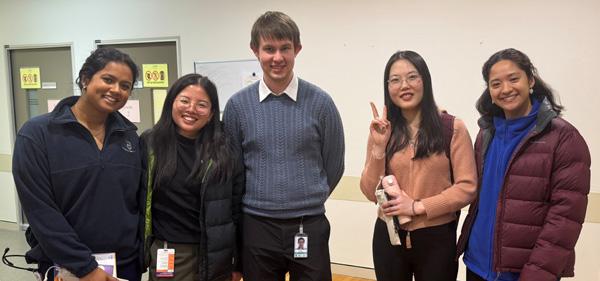

Dr Clair Bannerman, Dr Mel Deery, Dr Kerrie Aust and Dr John Deery at the RACGP Meetup.

Dr Kerrie Aust with Dr Sam Scanlan, Clinical Director of the Emergency Department at The Canberra Hospital.






At the RACGP fellowship ceremony in Canberra: Dr Rebekah Hoffman (ACT NSW President RACGP), Health Minister Rachel Stephen-Smith, Dr Kerrie Aust and new fellow Dr Chris Dickie.
women empower healthcare: are you ready to lead?
The AMA Women in Leadership Program is designed to inspire, empower, and support AMA women members to reach their full career potential. Through a structured blend of experiential learning and practical application, the program explores the unique challenges women face in leadership and provides the tools to navigate them with confidence.
By the end of the program, participants will:
understand core leadership principles
explore gender and intersectional barriers and enablers to career advancement
gain insight into power, influence, and the role of leadership
clarify personal drivers for leadership and purpose
engage with a dynamic network of women committed to making an impact.
This program is limited to 25 participants to ensure a highquality, interactive experience.
For full details and registration visit: ama.com.au/events/ women-in-leadership
After braving a chilly Canberra winter, nothing says “springtime in the capital” quite like Floriade, which returns this year from 13 September to 12 October 2025.
Over one million blooms will transform Commonwealth Park into a dazzling celebration of colour and curiosity as Australia’s Biggest Celebration of Spring embraces this year’s theme Science and Nature. Garden bed designs and events will draw inspiration from physics, chemistry, astronomy, biology, botany and more.
Visitors can enjoy hands-on workshops, fascinating talks and interactive displays—plus a special appearance by renowned Aussie scientist Dr Karl Kruszelnicki on Saturday 4 October.
The Kazador Tent brings extra sparkle to the program, hosting children’s shows during the school holidays including Children are Stinky and a variety of thrilling circus performances. Families can also head to Floriade Sprouts for fun craft and science activities, while foodies can browse markets, meet local producers and sample delicious treats. The program also includes the Windows to the World Showcase on Saturday 11 October (ahead of the main event on 18/19 October),

For more information visit floriadeaustralia.com
Dogs’ Day Out on Sunday 12 October, and the muchloved Great Big Bulb Dig on Monday 13 October— supporting YWCA Canberra. NightFest returns from 2 to 5 October, with illuminated blooms, installations, food, drink and live music every night, including headliners Josh Pyke (4 October) and Ella Hooper (5 October). The Kazador Tent transforms for Kiss Tease Cabaret – an 18+ experience filled with music, burlesque and highenergy variety acts. NightFest tickets are on sale now.

Doctors for the Environment
Australia is presenting the Health + Climate Forum from 4 - 6 September (online and in person) on Ngunnawal and Ngambri Country / Canberra. The three-day forum will bring together leaders in health, politics and advocacy to tackle how health is impacted by climate change, energy production and planetary health.
Held across Parliament House and Old Parliament House, the Forum will feature thought-provoking keynotes, evidence-based
discussions and practical workshops designed to equip participants with the tools to create change in our personal and professional lives.
AMA ACT President Dr Kerrie Aust will be taking part as a speaker on the first day of the program.
The event will explore how environmental policy and climate action shape the wellbeing of our communities – and demonstrate what we can all do to make a positive difference.
The full program is available online at: dea.org.au
Register at: qrco.de/bgFsbM


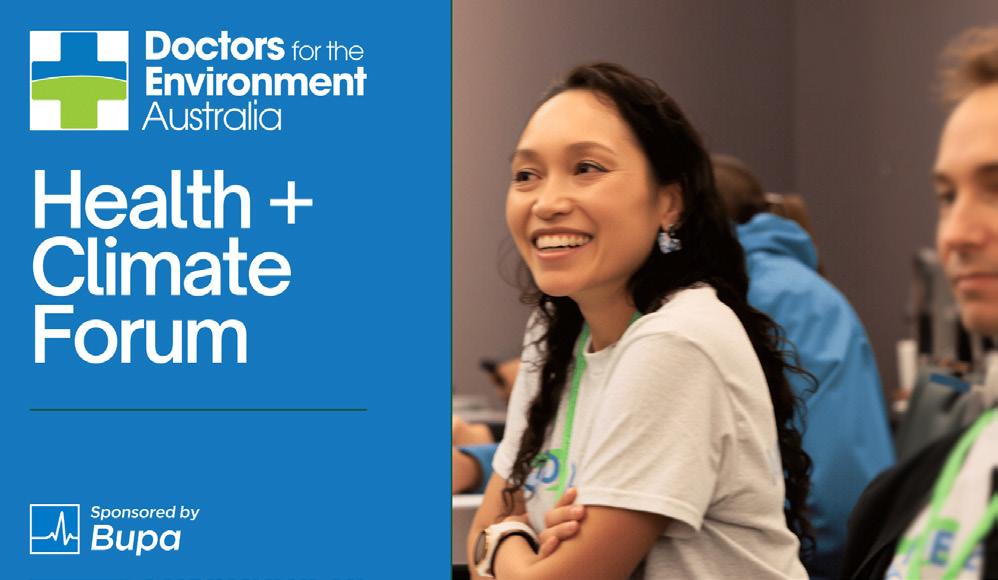

News Magazine for all Doctors in the Canberra Region
ISSN 13118X25
All electoral matter in this edition of Canberra Doctor is authorised by Peter Somerville on behalf of the Australian Medical Association (ACT) Ltd.
Published by the Australian Medical Association ACT Ltd
Level 1, 39 Brisbane Ave, Barton ACT 2600
(PO Box 560, Curtin ACT 2605)
Editorial Sarah Colyer sarah-colyer@ama-act.com.au
Design
Juliette Dudley reception@ama-act.com.au
Advertising
Ph 6270 5410 Fax 6273 0455 reception@ama-act.com.au
Contributions
Canberra Doctor welcomes reader contributions. Submit your stories to editorial@ama-act.com.au
The
The






See answers on page 12

This year’s ANU MedRevue, the hilarious and high-energy ‘Doccy Horror Picture Show’, raised a record-breaking $24,800 for Companion House — more than double the donations from previous years.
Nineteen years since the first ANU MedRevue, this year’s show involved 110 medical students and sold an impressive 910 tickets.
1. Who is superhero Green Arrow’s long-term love interest?
Producer Madeleine Fisk said the show was an enormous success. “This incredible achievement not only highlights the dedication of the cast and crew, but also leaves a lasting legacy of laughter, generosity, and social impact. We could not be more proud of what this year’s team accomplished.” Companion House is a nongovernment community based organisation that works with adults and children who have sought safety in Australia from persecution, torture and war related trauma.
2. Created by psychologist, William Moulton Marston, who is the world’s first great female superhero?
3. Who is the aunty of April, May and June, and godmother of Huey, Dewey, and Louie?
4. She destroyed the universe while a member of the Avengers.
5. Lois Lane became Superwoman in 2025 DC comics – true or false?
6. Batman has never had a female Robin – true or false?
7. Harley Quinn, before becoming a psychotic supervillain, was the Joker’s psychiatrist – true or false?
8. What do Superman’s son (also “Superman”), Hawkgirl, Green Lantern, Starman, Batwoman, Poison Ivy and Robin (Tim Drake) all have in common?
9. Who was assisted in fighting crime by Streaky the Super Cat?
Ph: 02 6260 5249
katherinegordiev.com.au

Dr Gordiev has Australian and international fellowship training and specialises in treatment of orthopaedic upper limb conditions, sporting injuries and trauma, including:
• shoulder replacement, repair, reconstruction, stabilisation including Latarjet
• operative shoulder/ upper limb fracture/ dislocation management
• biceps tendon repairs
7



• arthroscopic and open shoulder and elbow surgery
• cubital and carpal tunnel release
• surgery for arthritis, tendinitis, ganglions and traumatic conditions of the hand and wrist
Email: reception@katherinegordiev.com.au
Dr Fabian Chiong has recently joined NCMS to provide internal medicine & infectious diseases consultations. Dr Katherine Gordiev Orthopaedic Surgeon MBBS (Hons I) FRACS (Orth) FAOrthA







MBBS; FRACP; Dip Palliative Medicine (Clinical)
• Comprehensive Geriatric Assessments Cognitive & Capacity Assessments Falls Prevention Measures, Movements Disorders (Parkinson’s Disease)
• Medications Profile Optimisation and Goals of Care decisions Committed to elderly wellbeing and healthy ageing with a focus on improving functional, nutritional and psychosocial aspects

• Workplace and industrial relations advice
• List of Medical Services and Fees
• Events: Networking, workshops and webinars
• Member offers – wide variety of discounts and member-only deals for you and your family
• Lobbying and advocacy
• Wellbeing support services
• Limited legal assistance
– advice on routine legal matters impacting doctors
• Career consultations
• Subscription to Medical Journal of Australia


